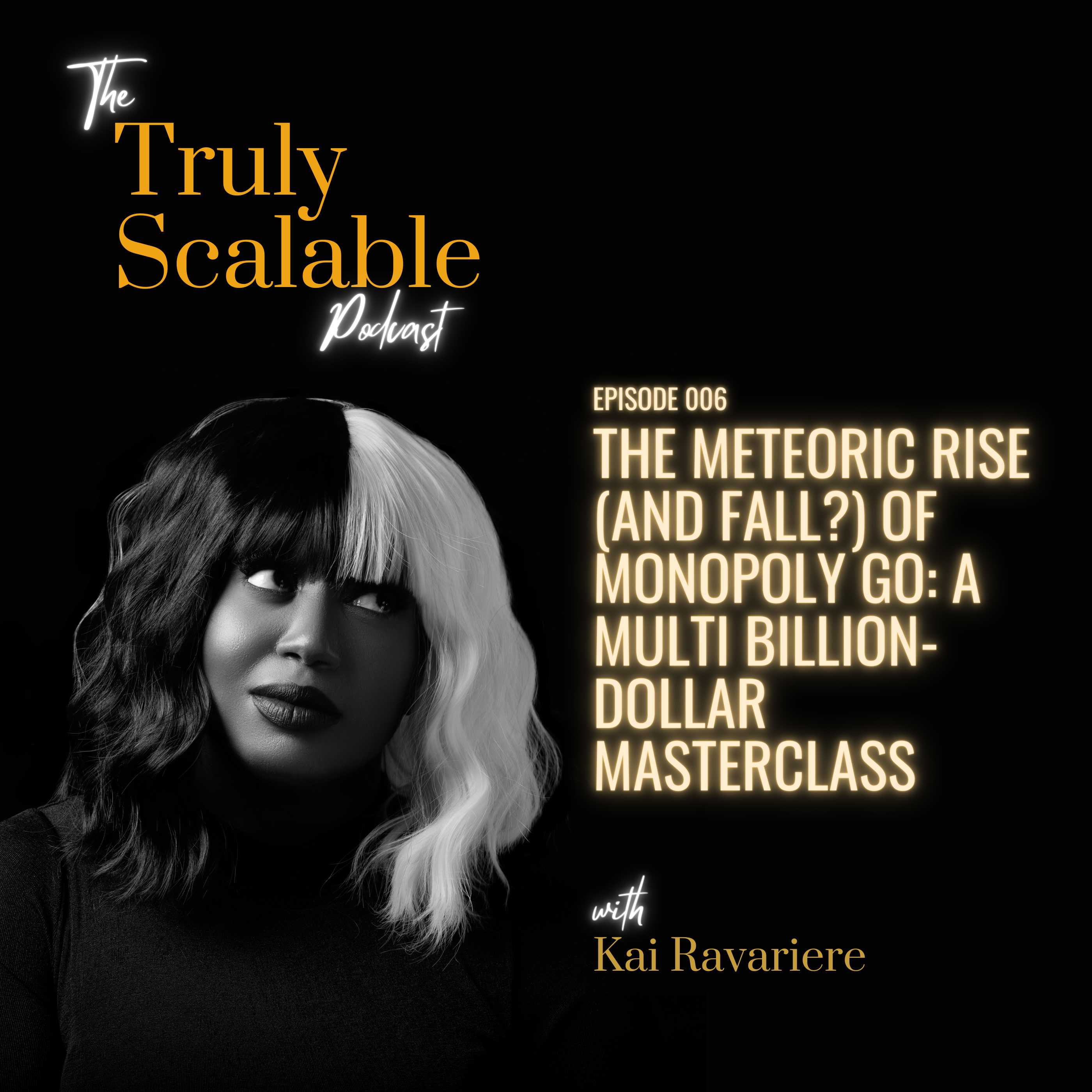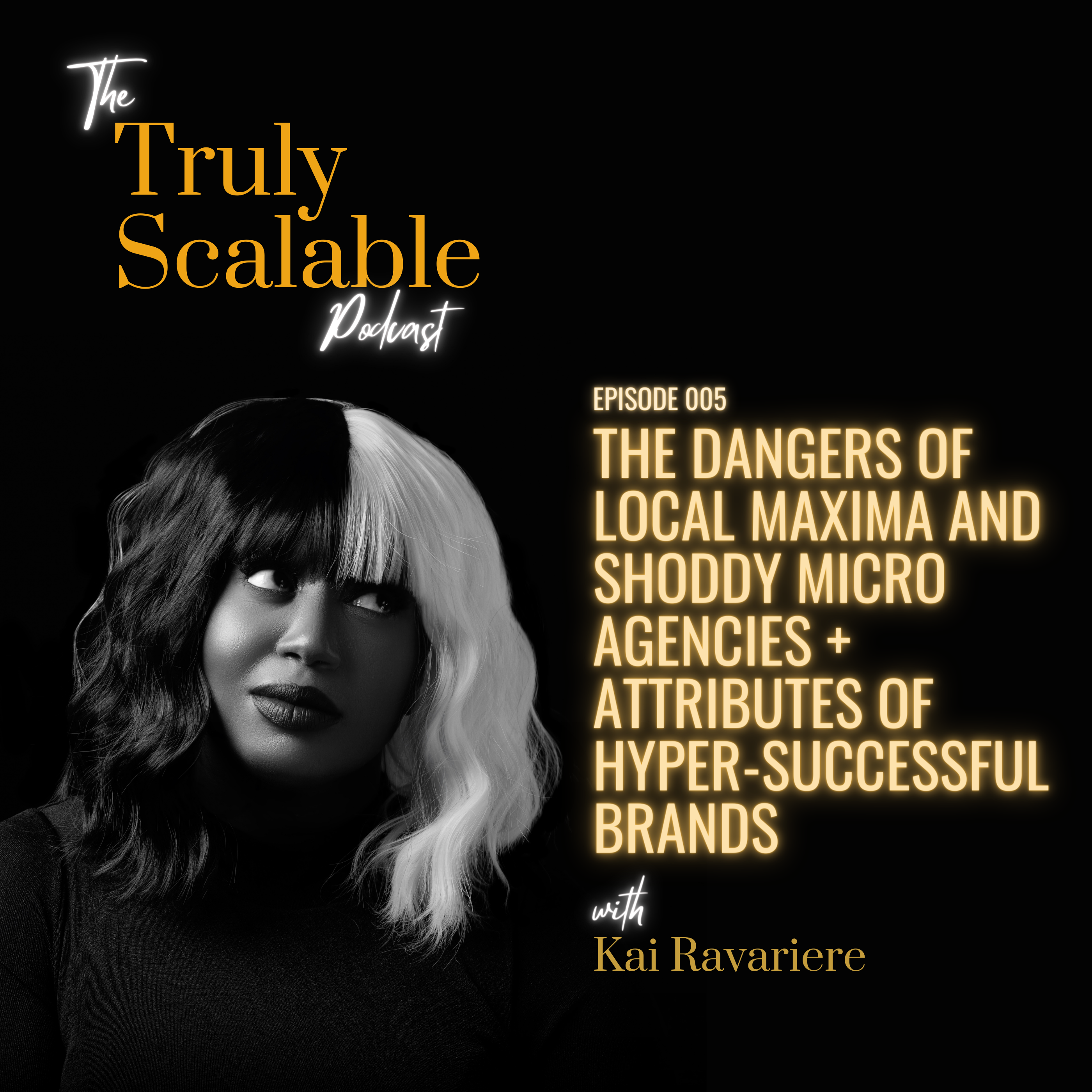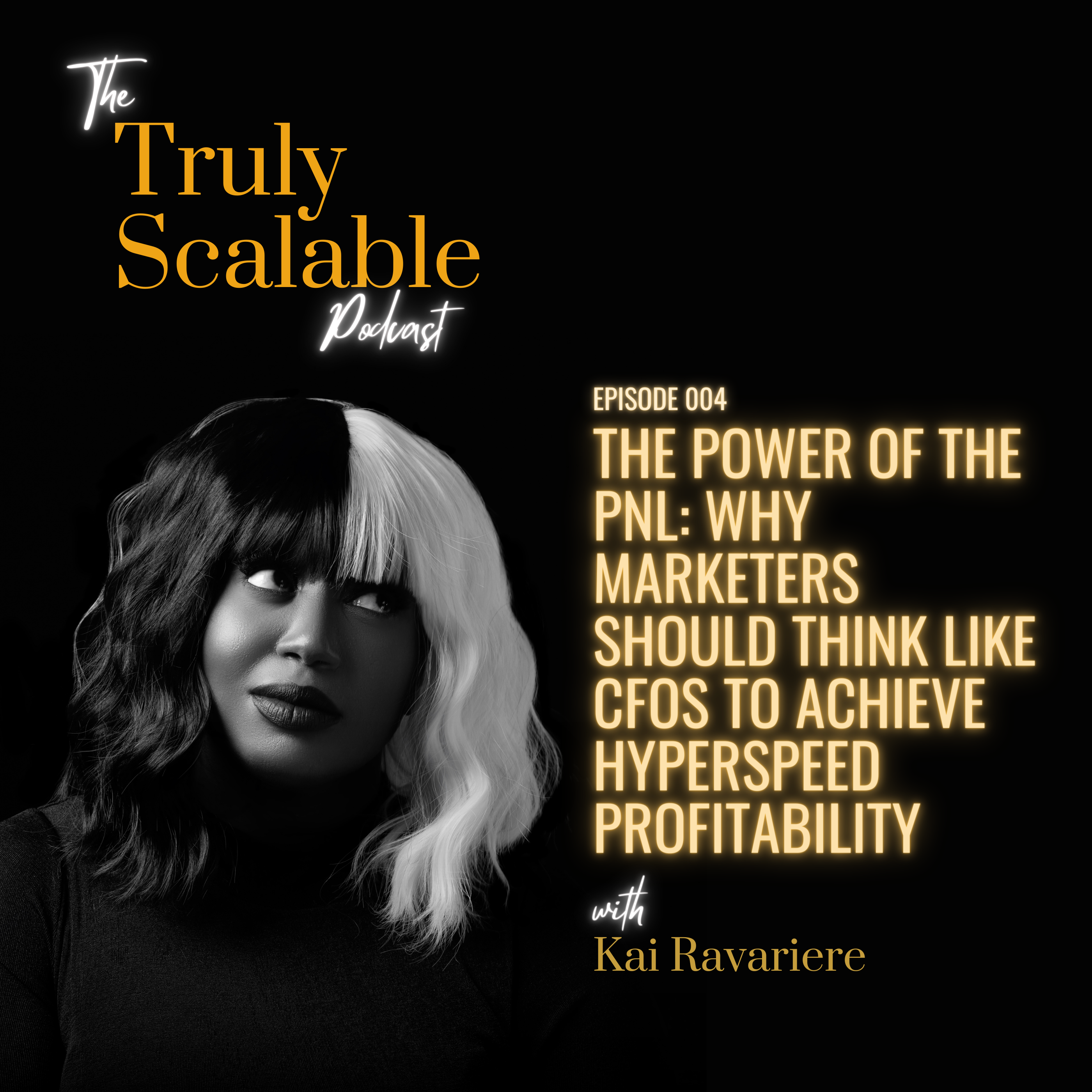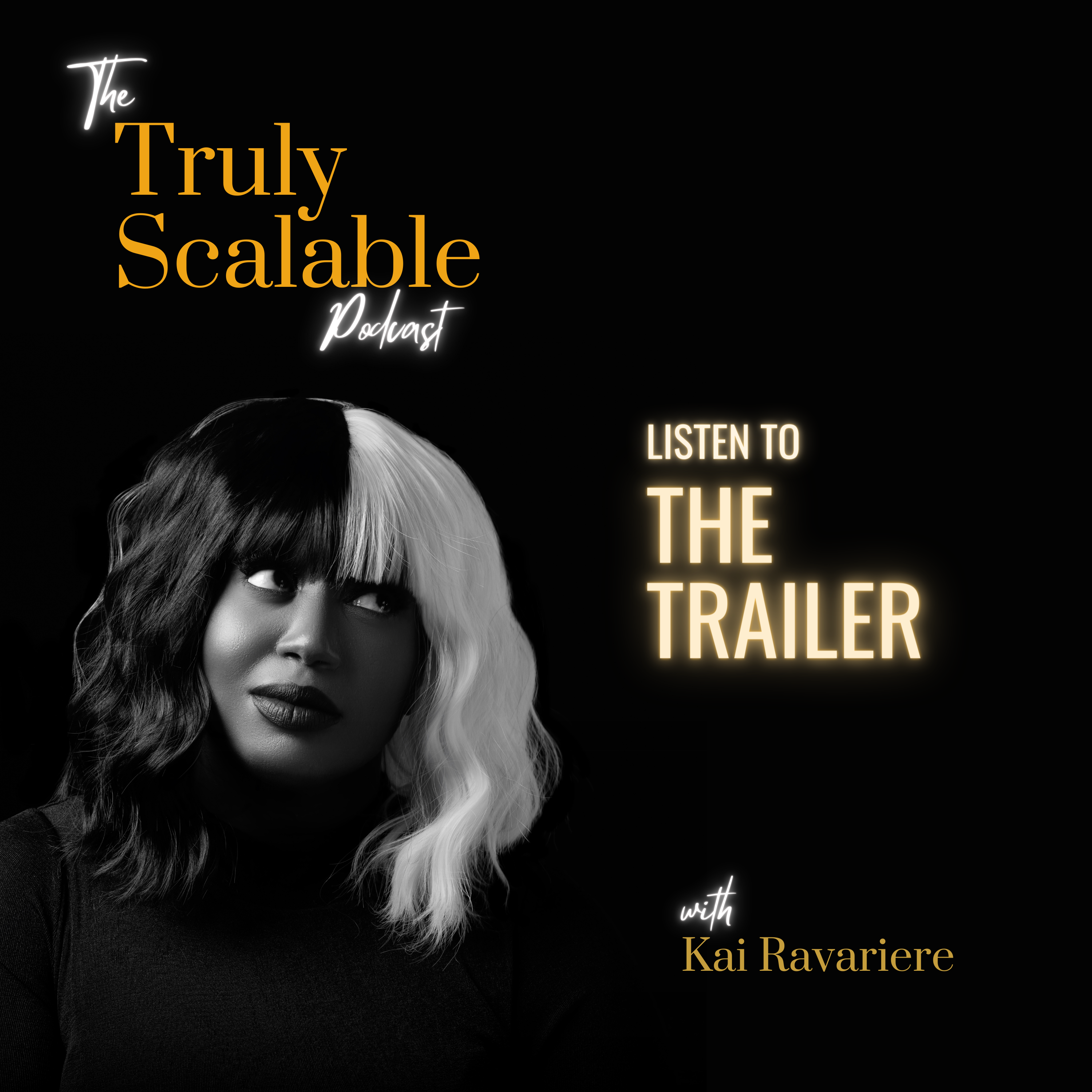Episode Transcript
[00:00:01] This is the Truly Scalable podcast, the inner mind of a paid media executive empowering ecommerce brands to optimize and strengthen the backbones of their brands, companies, teams and themselves to ensure a fast, highly profitable scaling, growth and success. However you define it, victories, failures, scandals, cautionary tales, lessons on growth scaling frameworks revelations in marketing and advertising... join me as I break down frameworks, dispel myths and shift paradigms for e commerce brand founders and CMOs to strengthen the makeup of their businesses and layer smart strategies for maximum profitability at scale. I'm Kai Ravariere and I'm here to help you become Truly Scalable.
[00:00:12] Kai: Hey, fam. Really excited about chatting with you, today. I’ve been itching to get into this with you ever since I fell down the Hasbro rabbit hole and started studying its most recent mega-success: Monopoly GO.
Now, listen. In an era where the digital transformation of classic games is not just a trend but a testament to their enduring appeal, "Monopoly GO" has come out of the gate with the level of success game developers fervently dream of. And the more I’ve studied the game, the marketing, the advertising, and the data play, the more convinced I am that Monopoly GO is a paragon of innovation.
Launched by Scopely in collaboration with Hasbro, this mobile adaptation not only reimagines the beloved board game for the digital age but also marks a monumental achievement in mobile gaming, amassing over $1 billion in revenue in only 7 months and well on its way to $2 billion before summer. Monopoly GO has become the fastest scaling game of its kind in history. Today, we’re going to explore the strategic maneuvers and data-driven decisions that propelled "Monopoly GO" beyond mere nostalgia, transforming it into a cultural and financial juggernaut.
I always try to keep our time together between 15 and 25 minutes for all the busy founders and executives out there, but… you guys there are just SO many juicy bits here that we’ve gotta make this a two-part mini-series to fit it all. This… is Part One.
First, I’m gonna get right to it and acknowledge that there are other marketers like Matej Lancaric, formerly of Pixel Federation and Superscale who have talked about and speculated on Monopoly GO’s success from a profitability perspective, asserting the likelihood of profitability at this stage is low.
And by all accounts from the brand, they’ve been dead wrong. There are many reasons why it makes sense to me that they would be and some are pretty obvious, so for sake of time today, let’s get into the three that are the least obvious to analysts and outsiders looking in.
They didn’t consider the paid traffic being run outside of Monopoly GO’s ad accounts, like with its offer wall advertising partnerships. While it’s true that Scopely is heavily running paid social and PPC traffic, insiders assert they’re doing so at a discount compared to most advertisers, meaning their CPC on their campaigns is significantly lower than other game advertisers.
Not only that, but they’ve employed lower-cost partnerships providing offer wall advertising with strategic incentives to not only download the app, but to play and participate in the game long enough for the addictive quality of the product to take hold and do the rest of the work to retain the user.
For instance, one of their affiliate partners is offering a $750 Sephora gift card in exchange for the completion of a number of offers, one of which includes downloading and playing Monopoly GO to Level 10. That requires at least a couple hours of game play, and by then what with all the addicting, gamified features inside the app itself which I’ll get into shortly, the likelihood that users will keep playing past Level 10 is higher than average for many mobile games.
Offer wall advertising can be an incredibly effective way to lower overall ad costs. And by paying for a premium Level 1 position on the offer wall, they ensure a higher likelihood of being selected by a user while they’re still hungry to get in on that gift card incentive. Generally offer wall advertising uses a plethora of various reward incentives to test to a large swath of audiences based on their interests determined by the platform, like TikTok, Facebook, or Taboola. Those who watch a lot of beauty and skincare content get an offer for a Sephora gift card, others who watch a lot of home improvement content may see an incentive from Home Depot, etc. Companies pay on a pay-per-click basis so that they only have to pay out when a user actually signs up for their specific offer, which in Scopely’s case, was downloading and playing Monopoly GO through Level 10.
This means they may pay a lot less for advertising than other advertisers using a more traditional route on paid social or Google PPC might, while reaching the same audiences.
While some may argue that offer wall advertising attracts audiences less likely to be interested in the secondary offers, that really depends on how aligned those offers are with their varied interests. Many of these offers, when placed correctly, can be really beneficial to users, and there’s a level of flexibility that allows visitors to choose which offers they’d be most interested in and would see as most valuable to their lives.
They overestimated the costs associated with running traffic. By using lower-cost placements that were less in demand, like in-feed ads inside the content feed of websites and apps and riding off the back of Monopoly’s strong brand and brand recognition, Scopely was able to secure media buys and meaningful clicks at a lower cost than other mobile games before them. With image creative that highlighted the nostalgic, classical elements of the game and featured the iconic Monopoly man, the widely recognizable board and classical tokens and game pieces, Scopely didn’t have to do a whole lot to persuade anyone who ever had memories of playing the classic boardgame to download and play the modern-day mobile version. Widely recognized brands tend to pay a great deal less per click than emerging ones, so it’s no surprise that when paired with lower-cost placements they’d find themselves in the highly coveted position of getting more bang for their buck than many other mobile games.
Nor did they stop to consider their retention marketing plays and the important role communities have played in their success that have taken their LTV to a whole new level.
The game features a progression system designed to not only unlock new levels, but new timed challenges and competitive tournaments within the levels that yield interaction with other live players, and games within the game designed to offer a way to earn more rolls, cash, and collectibles for free that can yield long term rewards.
It also features limited resources like dice that regenerate for free, up to a select number of rolls, after an hour, by the hour that then encourage return visits. This regeneration strategy comes complete with a countdown clock to illicit just enough impatience to consider skipping the wait and buying more rolls instead.
Not only does Monopoly GO have a variety of addictive game mechanics in-app, they also have off-app community platforms that motivate continuous gameplay by tapping into the very human need for social interaction. While the game does feature an ability to play with friends and family which encourages continuous play and additional purchases in-app in the long-term…
The social media and forum communities belonging to the app are where the real social interactions lie. By leveraging native features of these platforms, like push notifications and presenting content in feeds whenever a community member posts something, Monopoly GO is able to maintain a chokehold on players across multiple platforms, even when they’re not currently playing the game. That has contributed, in part, to these communities’ impressive stats. The Facebook and Discord groups alone for the game, for example, are astonishingly active, with over 10,000 posts a day taking place on Facebook as members sync with one another to trade cards, get tips, share memes, and bond on all things Monopoly GO.
They underestimated the efficacy of the game features that would take in-app purchases over the top.
The psychology that the game is built off of is very intentionally and strategically leveraged.
See, you have a finite amount of time to reach the milestone needed to win the reward, which only increases the urgency and drive to buy more dice before the clock for that particular reward runs out.
And there are countdowns within countdowns. Cash boosts that last only 8 or 9 minutes but double your earnings in that time, elusive wild cards to complete sets in your album that are only within reach if you complete a challenge in the next 24 hours, tournaments that only give you a day or two to make it to the top of the leaderboard to reap the most lucrative rewards, and rewards for completing multiple boards, or levels, within a very short period of time.
And of course, the big kahuna - 30 days to complete a 189 sticker album that unlocks the granddaddy of rewards, 15,000 dice rolls and several billion dollars.
The game is a masterclass in traversing scarcity and urgency, in a way that drives revenue but keeps the game fun… at least for a little while. I’ll get into that a bit later.
They also underestimated the very real lengths players are willing to go to win in this game. There is an entire black market that’s developed where players are selling, for real money, stickers that are rare or difficult to trade. What do the stickers accomplish? Well, those who collect them all get 15,000 rolls of the dice and billions of dollars in Monopoly money to play with. If their willingness to send cashapp and Zelle wires to complete strangers for digital trading stickers in a Facebook group, or their willingness to run entire scam operations for these digital stickers that, by the way, yields no real-world value is any indication… it’s safe to say that in-app purchases for these rolls and monopoly money are going to be booming, too. Anywhere you discover a black market developing, you’ll find two things, and the backdoor of an incredibly lucrative endeavor is one of them.
Scopely has rather effectively built a gotta-catch-em-all feature within the game that incentivizes the collection of stickers across a 189-sticker album that expires and refreshes every season. One that is, of course, managed by a countdown clock. This serves as the foundation for the digital communities across a variety of platforms like the Facebook communities and Discord, where hundreds of thousands of users connect with one another to trade these cards, get advice and tips, and be the first to know of in-app events, tournaments, challenges, and platform-exclusive giveaways. In my opinion, it’s the trading card feature of the app that not only grows the community but serves as the foundation of Monopoly GO’s retention strategy.
The other though, is a missed opportunity for the game developers to maximize revenue even more. Why can’t players roll to win a chance at spending real money to land a missing and elusive sticker? Sounds like a new challenge or tournament opportunity, to me.
There are, in fact, a number of flaws and opportunities within the game - and some of them could endanger Scopely’s chances of maintaining this meteoric momentum in the long run.
Monopoly GO is banking on the fact that by the time the user gets to, say, level 105, that they’re either so hooked that they’ll keep buying so they can keep playing, or that the peer pressure of playing with their family and friends will push them to keep buying so they don’t look like the person who can’t afford to play. The problem is that due to design flaws in the game, dopamine stops hitting once players feel the squeeze. Not unlike late-stage capitalism, as prices get higher and higher while rewards and cashouts remain more or less the same, it takes longer and longer to achieve milestones and level up to the next board. Board completion can go from taking a matter of minutes to several weeks. Which means the dopamine hit becomes weaker and more infrequent, and eventually most players stop playing because it’s just not that fun anymore… it’s just expensive. When a single upgrade on a landmark begins to cost $150 million while players are still getting rewards of $200,000 while being pushed multiple times to buy more cash or dice, and users are forced more and more to spend real money (in the magnitude of hundreds of dollars on a monthly or even weekly basis) in order to continue, players begin to wonder, “what’s the point?”
Just like we seem to find in late stage capitalism, the more time goes by, costs to play begin to skyrocket while the rewards and earnings remain comparatively flat.
Maybe the game mimics real-life capitalism a little too well.
While Scopely does a decent job of providing plenty of opportunities to feed the dopamine receptors, there are still major opportunities that have been missed. For instance, a lot of the boards, or levels, start to repeat themselves and look very similar to places the user has gone before. And milestones that you’d think would be milestones aren’t really celebrated in any real way. Nothing after 50 levels, 100 levels, etc. Now, no one really knows how many levels there are to Monopoly GO (though it’s estimated to be more than 850) but if completing a board can ultimately take weeks to achieve, it’s in the developers’ best interest to increase the supply of rewards (especially dice rolls). There’s a balance to be found and struck where Scopely can provide enough incentive for continuous game play while enjoying maximum retention and revenue…they just haven’t found the critical point of equilibrium just yet. Give users enough fishing line to really catch enough fish and they’ll stay on the lake for hours and come back to the lake every chance they get, for years to come.
The underground market that’s been created also threatens the maximization of backend or in-app revenue and LTV, as well. Because people do get scammed out of their stickers by unscrupulous players pretending to make fair trades, or enticed to share their player IDs only to have all their rewards and cash wiped out. And Scopely realizes this, having very recently built in an in-app card exchange feature that serves as the trading broker between players to curb scams. To what degree this has alleviated scams remains to be seen, but it is promising.
RECOMMENDATIONS
There are a few additional recommendations that could really optimize the game and ensure longevity as well. If Scopely and Hasbro really want to take this to the next level, they’ll put the app on full throttle and bring in real-world rewards wherever possible. How? Well, I can’t help but think about the Monopoly and McDonald’s partnership that existed decades back when I was a kid, which I know a lot of people also have fond nostalgia over. For those of you who don’t recall or are too young to remember, during a certain time of year, McDonald’s customers received game pieces attached to McDonald's products, like fries, apple pies, and drink cups, which corresponded to Monopoly properties. Just like the classic game’s rules, collecting a set of properties could win prizes ranging from free food, cars, and even serious amounts of cash. But you only had a certain amount of time to collect them before the game expired. The promotion encouraged repeat visits and product purchases, leveraging the popularity of Monopoly to engage customers and drive sales.
If I’m Scopely, I’m setting up a massive incentive where a couple lucky winners get real cash prizes up to $5 million. Real non-cash prizes, like cars, shopping sprees at retailers, anything in the luxury space to remain on-brand. However they do it: up the ante and optimize the duration of gameplay, and watch a lot of the concerns about in-app purchases disappear virtually overnight. The problem to solve is that users feel like they’re constantly being manipulated to spend real money on fake digital assets with little payoff. Monopoly GO is undoubtedly one of the most successful app-launches in history with some of the most addictive features that encourage real purchases. But increase the payoff, Scopely, and you just might find yourself with a $5 billion-a-year game.
Now that we dived into the nature of the product, stay tuned to the podcast in future episodes where we dive deeper into Monopoly GO’s marketing.
[00:15:50] Thanks for listening today. If this has been insightful, entertaining or interesting, subscribe and leave a review. They really do help. Drop some insight into topics you'd like to hear me get into too. I read all suggestions and we'll incorporate them into future episodes. Are you yearning to find better, smarter ways to scale and grow? Does the growing competition in this industry and the ever changing facets of digital advertising have you experiencing stagnant growth, declining revenue, or lack of profitability? Do you feel like you must be missing key pieces to the puzzle that would help you get to where you know your brand could and should be? Has your growth journey felt stressful, tedious, or underwhelming lately?
Sounds like you could use a GrowthGeek, our free weekly email newsletter that's packed with lessons, insights, perspectives on entrepreneurship, scaling, leadership and all things marketing and advertising for eCommerce. Sign up for free at www.trulyscalable.com/subscribe. Thanks again for joining me on this episode of Truly Scalable.




